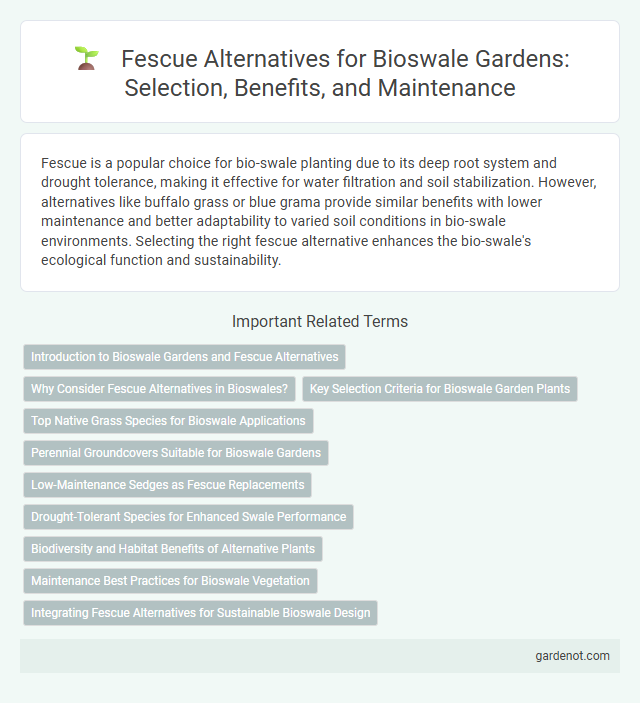Fescue is a popular choice for bio-swale planting due to its deep root system and drought tolerance, making it effective for water filtration and soil stabilization. However, alternatives like buffalo grass or blue grama provide similar benefits with lower maintenance and better adaptability to varied soil conditions in bio-swale environments. Selecting the right fescue alternative enhances the bio-swale's ecological function and sustainability.
Introduction to Bioswale Gardens and Fescue Alternatives
Bioswale gardens use vegetation like fescue grasses to filter stormwater and reduce runoff pollution effectively. Alternatives to traditional fescue include native grasses such as blue grama, buffalo grass, and switchgrass, which offer enhanced drought tolerance and deeper root systems for improved soil stabilization. Selecting these native species supports local biodiversity while optimizing water absorption and nutrient filtering in bioswale installations.
Why Consider Fescue Alternatives in Bioswales?
Fescue alternatives in bioswales enhance drought tolerance and reduce maintenance by offering native grasses and wildflowers that better adapt to local climate conditions. These alternatives improve biodiversity and support pollinators, contributing to healthier ecosystems in urban stormwater management. Selecting species with deep root systems promotes soil stabilization and maximizes water infiltration, optimizing bioswale performance.
Key Selection Criteria for Bioswale Garden Plants
Fescue alternatives for bioswale garden plants should prioritize drought tolerance, deep root systems, and low maintenance requirements to maximize water infiltration and soil stabilization. Native species such as Carex and Juncus varieties offer superior adaptation to local climates while enhancing pollutant filtration efficiency. Selecting plants with high biomass production supports sediment capture and nutrient uptake critical for bioswale performance.
Top Native Grass Species for Bioswale Applications
Top native grass species for bioswale applications include Big Bluestem (Andropogon gerardii), Switchgrass (Panicum virgatum), and Little Bluestem (Schizachyrium scoparium), all known for their deep root systems and drought tolerance. These grasses enhance soil stabilization, improve water infiltration, and support pollutant filtration in bioswales. Selecting native fescue alternatives like Prairie Dropseed (Sporobolus heterolepis) and Indian Grass (Sorghastrum nutans) can optimize bioswale effectiveness while promoting local biodiversity.
Perennial Groundcovers Suitable for Bioswale Gardens
Perennial groundcovers such as creeping thyme, ajuga, and sedum provide effective alternatives to fescue in bioswale gardens by enhancing soil stabilization and reducing erosion. These plants offer deep root systems that improve water infiltration and pollutant filtration in bioswale environments. Selecting drought-tolerant and low-maintenance species supports sustainable stormwater management and promotes long-term bioswale functionality.
Low-Maintenance Sedges as Fescue Replacements
Low-maintenance sedges such as Carex oshimensis and Carex appressa offer excellent alternatives to traditional fescue for bio-swales, thriving in both wet and dry conditions while requiring minimal irrigation. These sedges improve soil stabilization and enhance water filtration by efficiently managing stormwater runoff, reducing erosion and promoting groundwater recharge. Their deep root systems provide superior resilience and sustainability, making them ideal for eco-friendly, low-maintenance landscaping in urban environments.
Drought-Tolerant Species for Enhanced Swale Performance
Selecting drought-tolerant species such as Buffalo grass and Blue grama improves bio-swale resilience and water retention during dry periods. Fescue alternatives with deep root systems enhance soil stabilization and reduce erosion in swale environments. Integrating native, drought-resistant plants maximizes swale performance by maintaining infiltration rates and minimizing irrigation needs.
Biodiversity and Habitat Benefits of Alternative Plants
Choosing fescue alternatives such as native wildflowers and sedges enhances biodiversity by providing diverse habitats for pollinators, birds, and beneficial insects within bio-swales. These plants improve ecological resilience by supporting a wider range of species and promoting soil health through extensive root systems. Incorporating native alternatives contributes to habitat restoration and strengthens ecosystem services beyond those offered by monoculture fescue plantings.
Maintenance Best Practices for Bioswale Vegetation
Selecting fescue alternatives such as native grasses and sedges for bioswale vegetation enhances drought tolerance and reduces mowing frequency. Maintenance best practices include regular monitoring for invasive species, periodic mulching to retain soil moisture, and targeted irrigation during establishment phases to promote deep root growth. Implementing adaptive mowing height strategies supports plant health and pollutant filtration efficiency in bioswales.
Integrating Fescue Alternatives for Sustainable Bioswale Design
Integrating fescue alternatives such as native grasses like buffalo grass, switchgrass, and blue grama enhances the sustainability of bioswale design by improving water infiltration and reducing maintenance requirements. These drought-tolerant species support greater biodiversity and resilience against erosion compared to traditional fescue. Utilizing native alternatives optimizes bioswale performance, promoting cleaner stormwater management and contributing to urban ecological health.
Fescue alternative Infographic

 gardenot.com
gardenot.com